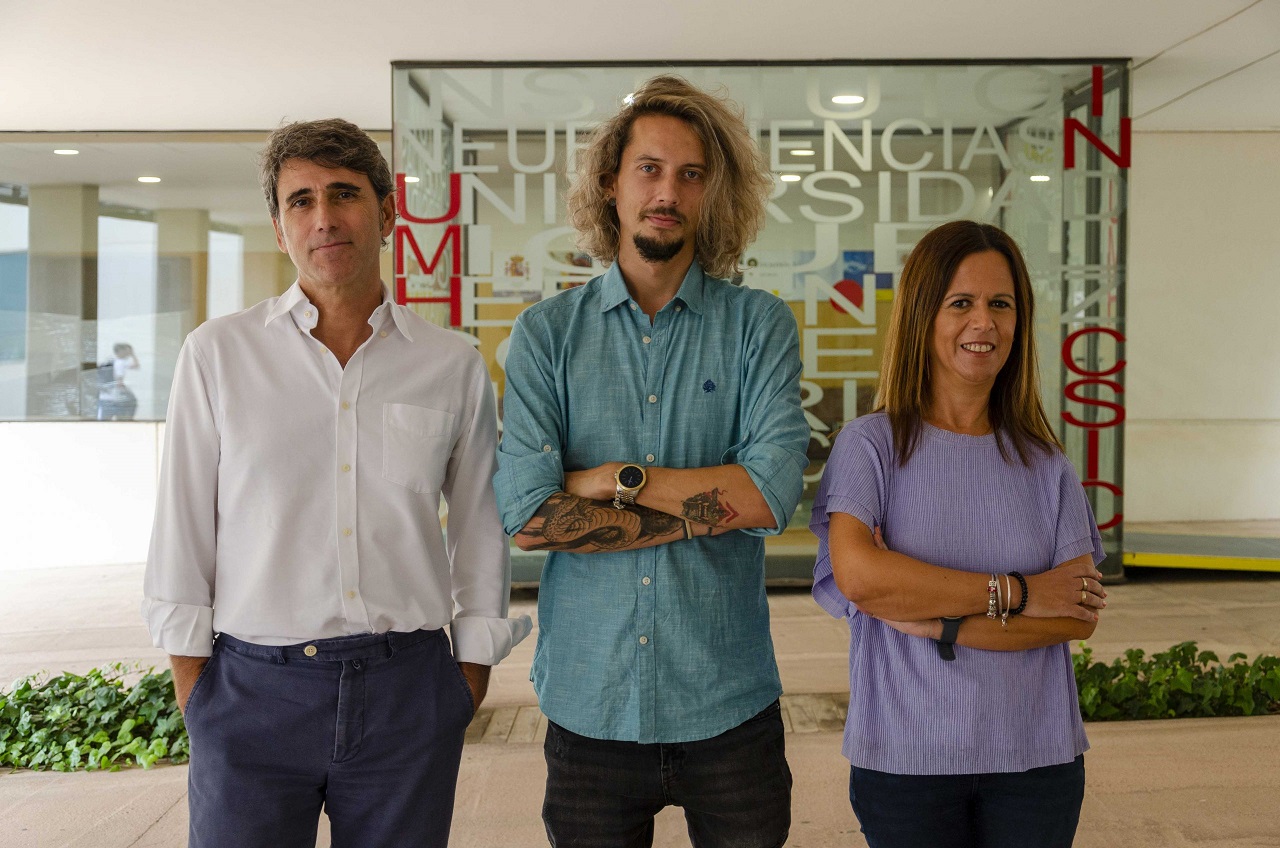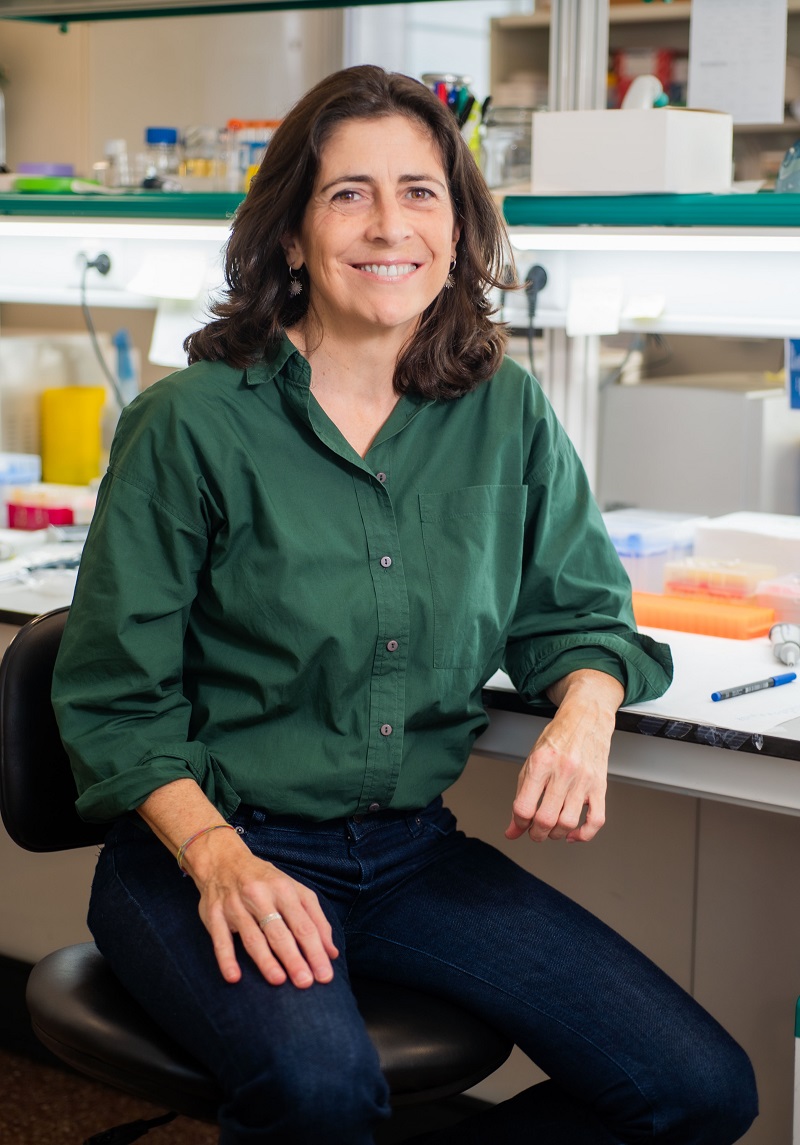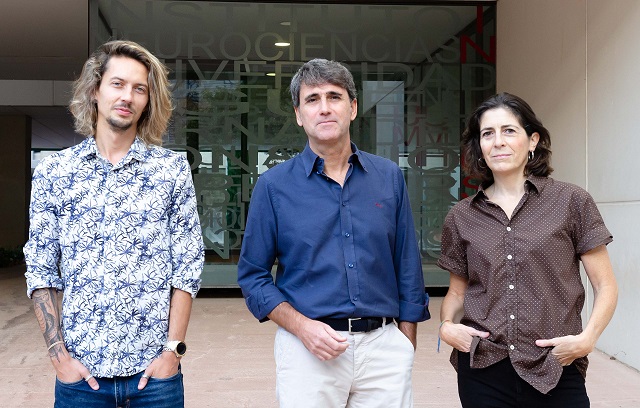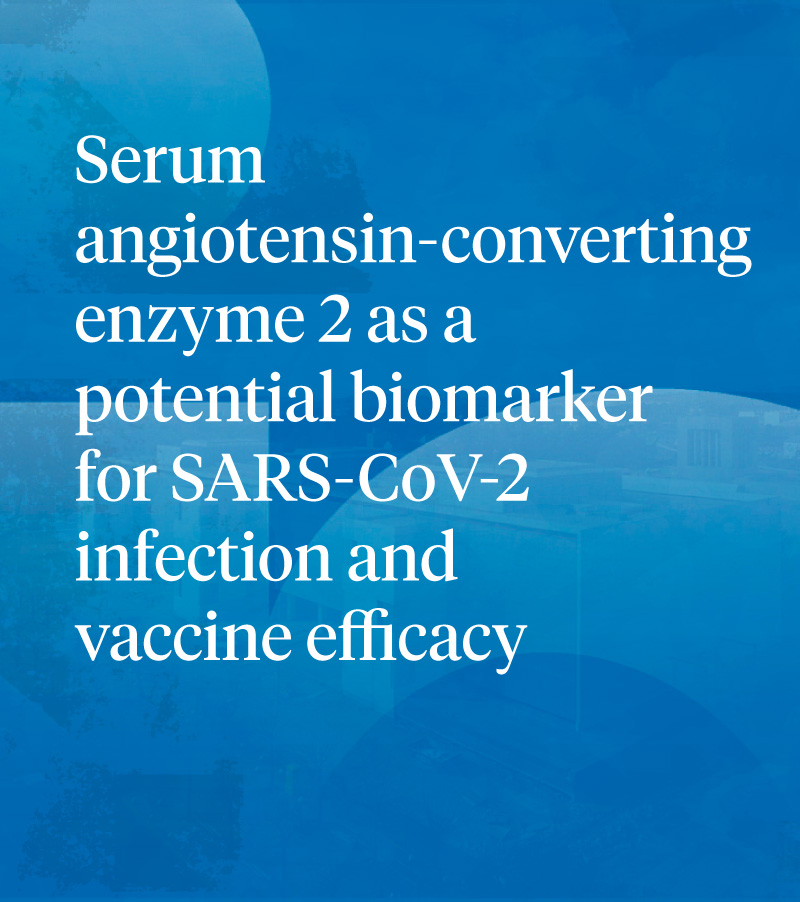Lines of investigation
Our research line is focused in Alzheimer’s disease (AD), but with interest in other neurodegenerative disorders. Translationality of our research lies in we aim to clarify the pathological mechanisms which underlie the disease searching potential diagnostic tools and/or processes with therapeutic relevance. Our group is part of CIBERNED (an ISC-III Center for Networked Biomedical Research focused in neurodegenerative diseases) with members from FISABIO (Foundation for the promotion of health and biomedical research of the Valencian Community) and ISABIAL (Institute of Health and Biomedical Research of Alicante). In recent years, we have been involved in a project of the EU Joint Programming in Neurodegenerative Disease, BIOMARKAPD, an European consortium that aimed to validate classical markers and refine protocols for analysis. Our group is part of the “Society for CSF analysis and clinical neurochemistry”.
Our expertise comprises i) biochemical characterization of PTM for brain/CSF proteins, including glycosylation, phosphorylation, and characterization of proteolytic processing; ii) characterization of ligand-receptor interaction associated to signaling pathways; iii) assessment of sustained inhibition of key enzymes such as cholinesterases and secretases.
Among the recent studies there are: i) β-amyloid (Aβ) and tau hyperphosphorylation (P-tau) cross-talk, role for the reelin protein. Reelin is a signaling protein that modulates synaptic function and plasticity in the brain through interaction with apolipoprotein E receptors. ApoE is the major genetic risk factor for sporadic AD. We demonstrated a novel mechanism by which Aβ regulates reelin expression and glycosylation, thereby influencing its signaling cascade. We also described new apolipoprotein E receptor that influenced amyloid processing. ii) Interaction and modulation of acetylcholinesterase by P-tau and the role of presenilin 1 in the glycosylation and functional location of acetylcholinesterase. iii) Development of new CSF biomarkers, evaluating the diagnostic potential of particular glycoforms of proteins (including APP), which improve sensitivity and specificity of the biomarkers. We also identify in the CSF several secretases and APP photolytic fragments. We are part of the team involved in the report of the new ADAM10 Tyr167* nonsense mutation in familial AD. More recently, we analyzed different circulating ACE2, the host receptor of SARS-CoV-2 coronavirus, soluble full-length species and proteolytic fragments, as an informative biomarker of the progression of the COVID-19 disease as well as therapy efficacy, including vaccination.
Representative Publications
- Increased Cerebrospinal Fluid Angiotensin-Converting Enzyme 2 Fragments as a Read-Out of Brain Infection in Patients With COVID-19 Encephalopathy. Matthew P Lennol, María-Salud García-Ayllón, Carlos Avilés-Granados, Chiara Trasciatti, Chiara Tolassi, Virginia Quaresima, Davide Arici, Viviana Cristillo, Irene Volonghi, Francesca Caprioli, Valeria De Giuli, Sara Mariotto, Sergio Ferrari, Gianluigi Zanusso, Nicholas J Ashton, Henrik Zetterberg, Kaj Blennow, Alessandro Padovani, Andrea Pilotto, Javier Sáez-Valero. The Journal of Infectious Diseases. 2025 231(5): e929–e940 https://doi.org/10.1093/infdis/jiaf093
- Alterations of NMDAR Subunits in the Cerebrospinal Fluid Across Neurodegenerative and Immunological Disorders. Sergio Escamilla , Rocío Pérez-González, Carmen Márquez-Marco, Elena Camporesi, Gunnar Brinkmalm ,, Alessandro Padovani , Andrea Pilotto , Chiara Tolassi , Davide Arici, Irene Volonghi , Henrik Zetterberg, Kaj Blennow ,Jesús Pérez-Pérez ,, Jaime Kulisevsky , Inmaculada Cuchillo-Ibáñez ,Javier Sáez-Valero. J Neurochem. 2025 169(8): e70192 https://doi.org/10.1111/jnc.70192
- Risk for COVID-19 Vulnerability in Patients with Inflammatory Bowel Disease: Assessing Alterations in ACE2 and TMPRSS2. Jorge Sáez-Leyva , Matthew P Lennol , Carlos Avilés-Granados,, María-Salud García-Ayllón, Javier Sáez-Valero Biomedicines. 2025 Review; 13(9): 2240 https://doi.org/10.3390/biomedicines13092240
- Synaptic and extrasynaptic distribution of NMDA receptors in the cortex of Alzheimer’s disease patients. Escamilla S, Badillos R, Comella JX, Solé M, Pérez-Otaño I, Sánchez Mut JV, Sáez-Valero J and Cuchillo-Ibáñez I. Alzheimer's & Dementia 2024 1-15 (in press) https://doi.org/10.1002/alz.14125
- NMDARs in Alzheimer’s Disease: Between Synaptic and Extrasynaptic Membranes. Sergio Escamilla, Javier Sáez-Valero and Inmaculada Cuchillo-Ibáñez. Int. J. Mol. Sci. 2024 25(18), 10220 https://doi.org/10.3390/ijms251810220
- Serum angiotensin-converting enzyme 2 as a potential biomarker for SARS-CoV-2 infection and vaccine efficacy. Lennol, M.P., García-Ayllón, M.-S., Esteban, M., García-Arriaza, J., Sáez-Valero, J. Frontiers in Immunology 2022 13: art 1001951 https://doi.org/10.3389/fimmu.2022.1001951
- Amyloid precursor protein glycosylation is altered in the brain of patients with Alzheimer’s disease Boix CP, Lopez-Font I, Cuchillo-Ibañez I, Sáez-Valero J Alzheimers Res Ther 2020 12(1):96 https://doi.org/10.1186/s13195-020-00664-9
- Inhibition of gamma-Secretase Leads to an Increase in Presenilin-1 Sogorb-Esteve A, Garcia-Ayllon MS, Llansola M, Felipo V, Blennow K, Saez-Valero J Mol Neurobiol 2018 55(6):5047 https://doi.org/10.1007/s12035-017-0705-1
- Levels of ADAM10 are reduced in Alzheimer’s disease CSF Sogorb-Esteve A, Garcia-Ayllon MS, Gobom J, Alom J, Zetterberg H, Blennow K, Saez-Valero J J Neuroinflammation 2018 15:213 https://doi.org/10.1186/s12974-018-1255-9
- Cerebrospinal fluid Presenilin-1 increases at asymptomatic stage in genetically determined Alzheimer’s disease Sogorb-Esteve A, Garcia-Ayllon MS, Fortea J, Sanchez-Valle R, Lleo A, Molinuevo JL, Saez-Valero J Mol Neurodegener 2016 11:66 https://doi.org/10.1186/s13024-016-0131-2
- Risk for COVID-19 Vulnerability in Patients with Inflammatory Bowel Disease: Assessing Alterations in ACE2 and TMPRSS2. Jorge Sáez-Leyva , Matthew P Lennol , Carlos Avilés-Granados,, María-Salud García-Ayllón, Javier Sáez-Valero Biomedicines. 2025 Review; 13(9): 2240 https://doi.org/10.3390/biomedicines13092240
- Alterations of NMDAR Subunits in the Cerebrospinal Fluid Across Neurodegenerative and Immunological Disorders. Sergio Escamilla , Rocío Pérez-González, Carmen Márquez-Marco, Elena Camporesi, Gunnar Brinkmalm ,, Alessandro Padovani , Andrea Pilotto , Chiara Tolassi , Davide Arici, Irene Volonghi , Henrik Zetterberg, Kaj Blennow ,Jesús Pérez-Pérez ,, Jaime Kulisevsky , Inmaculada Cuchillo-Ibáñez ,Javier Sáez-Valero. J Neurochem. 2025 169(8): e70192 https://doi.org/10.1111/jnc.70192
- Increased Cerebrospinal Fluid Angiotensin-Converting Enzyme 2 Fragments as a Read-Out of Brain Infection in Patients With COVID-19 Encephalopathy. Matthew P Lennol, María-Salud García-Ayllón, Carlos Avilés-Granados, Chiara Trasciatti, Chiara Tolassi, Virginia Quaresima, Davide Arici, Viviana Cristillo, Irene Volonghi, Francesca Caprioli, Valeria De Giuli, Sara Mariotto, Sergio Ferrari, Gianluigi Zanusso, Nicholas J Ashton, Henrik Zetterberg, Kaj Blennow, Alessandro Padovani, Andrea Pilotto, Javier Sáez-Valero. The Journal of Infectious Diseases. 2025 231(5): e929–e940 https://doi.org/10.1093/infdis/jiaf093
- Small RNAs in plasma extracellular vesicles define biomarkers of premanifest changes in Huntington’s disease. Marina Herrero-Lorenzo, Jesús Pérez-Pérez, Georgia Escaramís, Saül Martínez-Horta, Rocío Pérez-González, Elisa Rivas-Asensio, Jaime Kulisevsky, Ana Gámez-Valero, Eulàlia Martí. Journal of extracellular vesicles. 2024 13(10): e12522 https://doi.org/10.1002/jev2.12522
- NMDARs in Alzheimer’s Disease: Between Synaptic and Extrasynaptic Membranes. Sergio Escamilla, Javier Sáez-Valero and Inmaculada Cuchillo-Ibáñez. Int. J. Mol. Sci. 2024 25(18), 10220 https://doi.org/10.3390/ijms251810220
- Evidence for a novel neuronal mechanism driving Alzheimer’s disease, upstream of amyloid. Sara Garcia Ratés, María-Salud García-Ayllón, Neus Falgàs, Sharon A. Brangman, Margaret M Esiri, Clive W. Coen, Susan Adele Greenfield. Alzheimer's and Dementia. 2024 20(7): 5027-5034 https://doi.org/10.1002/alz.13869
- Synaptic and extrasynaptic distribution of NMDA receptors in the cortex of Alzheimer’s disease patients. Escamilla S, Badillos R, Comella JX, Solé M, Pérez-Otaño I, Sánchez Mut JV, Sáez-Valero J and Cuchillo-Ibáñez I. Alzheimer's & Dementia 2024 1-15 (in press) https://doi.org/10.1002/alz.14125
- Transient Changes in the Plasma of Astrocytic and Neuronal Injury Biomarkers in COVID-19 Patients without Neurological Syndromes. Lennol, M.P.; Ashton, N.J.; Moreno-Pérez, O.; García-Ayllón, M.-S.; Ramos-Rincon, J.-M.; Andrés, M.; León-Ramírez, J.-M.; Boix, V.; Gil, J.; Blennow, K.; et al. Int. J. Mol. Sci. 2023 24(3): 2715 https://doi.org/10.3390/ijms24032715
- Presenilin 1 Modulates Acetylcholinesterase Trafficking and Maturation. Cortés-Gómez, M.Á., Barberá, V.M., Alom, J., Sáez-Valero, J., García-Ayllón, M.-S. Int J Mol Sci. 2023 24(2): art. 1437 https://doi.org/10.3390/ijms24021437
- No evidence for cognitive decline or neurodegeneration in strain-matched Grin3a knockout mice. Remy Verhaeghe, Oscar Elía-Zudaire, Sergio Escamilla, Javier Sáez-Valero, Isabel Pérez-Otaño Alzheimer's & Dementia. 2023 19 (9), pp. 4264 - 4266 https://doi.org/10.1002/alz.13375
- ADAM10 Gene Variants in AD Patients and Their Relationship to CSF Protein Levels. Pablo Agüero-Rabes , Julián Pérez-Pérez , Lucía Cremades-Jimeno, María-Salud García-Ayllón , Adriana Gea-González , María José Sainz, Ignacio Mahillo-Fernández , Raquel Téllez , Blanca Cárdaba , Javier Sáez-Valero and Estrella Gómez-Tortosa Int. J. Mol. Sci. 2023 24 (7), 6113 https://doi.org/10.3390/ijms24076113
- BACE2 beyond β-processing of APP, its neuroprotective role in cerebrovascular endothelium. Javier Sáez-Valero, Rocío Pérez-González Journal of Neurochemistry. 2023 166 (6): 887-890 - Editorial https://doi.org/10.1111/jnc.15940
- Validity of CSF alpha-synuclein to predict psychosis in prodromal Alzheimer’s disease. Sonia Monge-García, María-Salud García-Ayllón, José Sánchez-Payá, Ruth Gasparini-Berenguer, María- Ángeles Cortés-Gómez, Javier Sáez-Valero, José-Antonio Monge-Argilés Front. Neurol. 2023 Sec. Neurological Biomarkers, Volume 14 - 2023 https://doi.org/10.3389/fneur.2023.1124145
- Altered Balance of Reelin Proteolytic Fragments in the Cerebrospinal Fluid of Alzheimer’s Disease Patients. Lopez-Font, I., Lennol, M.P., Iborra-Lazaro, G., Zetterberg, H., Blennow, K., Sáez-Valero, J. Int J Mol Sci . 2022 23 (14): art. 7522 https://doi.org/10.3390/ijms23147522
- Proceedings of workshop: “Neuroglycoproteins in health and disease”, INNOGLY cost action Llop, E., Ardá, A., Zacco, E., O’Flaherty, R., García-Ayllón, M.-S., Aureli, M., Frenkel-Pinter, M., Reis, C.A., Greiner-Tollersrud, O.K., Cuchillo-Ibáñez, I. Glycoconj Journal. 2022 39(5): 579-586 https://doi.org/10.1007/s10719-022-10078-4
- Sex Differentially Alters Secretion of Brain Extracellular Vesicles During Aging: A Potential Mechanism for Maintaining Brain Homeostasis. Kim, Y., Pérez-González, R., Miller, C., Kurz, M., D’Acunzo, P., Goulbourne, C.N., Levy, E. Neurochem Res. 2022 47(11) :3428-3439 https://doi.org/10.1007/s11064-022-03701-1
- Isolation of mitochondria-derived mitovesicles and subpopulations of microvesicles and exosomes from brain tissues. D’Acunzo, P., Kim, Y., Ungania, J.M., Pérez-González, R., Goulbourne, C.N., Levy, E. Nat Protoc. 2022 17(11): 2517-2549 - Review https://doi.org/10.1038/s41596-022-00719-1
- Apolipoprotein E imbalance in the cerebrospinal fluid of Alzheimer’s disease patients Matthew Paul Lennol, Irene Sánchez-Domínguez, Inmaculada Cuchillo-Ibañez, Elena Camporesi, Gunnar Brinkmalm, Daniel Alcolea, Juan Fortea, Alberto Lleó, Guadalupe Soria, Fernando Aguado, Henrik Zetterberg, Kaj Blennow & Javier Sáez-Valero Alzheimer's Research & Therapy 2022 14, Article number: 161 (2022) https://doi.org/10.1186/s13195-022-01108-2
- Serum angiotensin-converting enzyme 2 as a potential biomarker for SARS-CoV-2 infection and vaccine efficacy. Lennol, M.P., García-Ayllón, M.-S., Esteban, M., García-Arriaza, J., Sáez-Valero, J. Frontiers in Immunology 2022 13: art 1001951 https://doi.org/10.3389/fimmu.2022.1001951
- Plasma ACE2 species are differentially altered in COVID-19 patients García-Ayllón MS, Moreno-Pérez O, García-Arriaza J, Ramos-Rincón JM, Cortés-Gómez MÁ, Brinkmalm G, Andrés M, León-Ramírez JM, Boix V, Gil J, Zetterberg H, Esteban M, Merino E, Sáez-Valero J FASEB J 2021 35(8):e21745 https://doi.org/10.1096/fj.202100051R
- Increased P2x2 receptors induced by amyloid-beta peptide participates in the neurotoxicity in alzheimer’s disease Godoy PA, Mennickent D, Cuchillo-Ibáñez I, Ramírez-Molina O, Silva-Grecchi T, Panes-Fernández J, Castro P, Sáez-Valero J, Fuentealba J Biomed Pharmacother 2021 142:111968 https://doi.org/10.1016/j.biopha.2021.111968
- Relation between Alpha-Synuclein and Core CSF Biomarkers of Alzheimer’s Disease Monge-García V, García-Ayllón MS, Sáez-Valero J, Sánchez-Payá J, Navarrete-Rueda F, Manzanares-Robles J, Gasparini-Berenguer R, Romero-Lorenzo R, Cortés-Gómez MA, Monge-Argilés JA Medicina (Kaunas) 2021 57(9):954 https://doi.org/10.3390/medicina57090954
- Tau phosphorylation by glycogen synthase kinase 3 beta modulates enzyme acetylcholinesterase expression Cortés-Gómez MÁ, Llorens-Álvarez E, Alom J, Del Ser T, Avila J, Sáez-Valero J, García-Ayllón MS J Neurochem 2021 157(6):2091 https://doi.org/10.1111/jnc.15189
- The apolipoprotein receptor LRP3 compromises APP levels Cuchillo-Ibañez I, Lennol MP, Escamilla S, Mata-Balaguer T, Valverde-Vozmediano L, Lopez-Font I, Ferrer I, Sáez-Valero J Alzheimers Res Ther 2021 13(1):181 https://doi.org/10.1186/s13195-021-00921-5
- Amyloid precursor protein glycosylation is altered in the brain of patients with Alzheimer’s disease Boix CP, Lopez-Font I, Cuchillo-Ibañez I, Sáez-Valero J Alzheimers Res Ther 2020 12(1):96 https://doi.org/10.1186/s13195-020-00664-9
- a-Secretase nonsense mutation (ADAM10 Tyr167*) in familial Alzheimer’s disease Agüero P, Sainz MJ, García-Ayllón MS, Sáez-Valero J, Téllez R, Guerrero-López R, Pérez-Pérez J, Jiménez-Escrig A, Gómez-Tortosa E Alzheimers Res Ther 2020 12(1):139 https://doi.org/10.1186/s13195-020-00708-0
- Elevated Plasma Reelin Levels in Children With Autism Cuchillo-Ibáñez I, Andreo-Lillo P, Pastor-Ferrándiz L, Carratalá-Marco F, Sáez-Valero J Front Psychiatry 2020 11:242 https://doi.org/10.3389/fpsyt.2020.00242
- Decreased circulating ErbB4 ectodomain fragments as a read-out of impaired signaling function in amyotrophic lateral sclerosis Lopez-Font I, Sogorb-Esteve A, Javier-Torrent M, Brinkmalm G, Herrando-Grabulosa M, García-Lareu B, Turon-Sans J, Rojas-García R, Lleó A, Saura CA, Zetterberg H, Blennow K, Bosch A, Navarro X4, Sáez-Valero J Neurobiology of Disease 2019 124:428 https://doi.org/10.1016/j.nbd.2018.12.021
- Pre-analytical stability of novel cerebrospinal fluid biomarkers Willemse EAJ, Vermeiren Y, Garcia-Ayllon MS, Bridel C, De Deyn PP, Engelborghs S, van der Flier WM, Jansen EEW, Lopez-Font IB, Mendes V, Manadas B, de Roeck N, Saez-Valero J, Struys EA, Vanmechelen E, Andreasson U, Teunissen CE Clinica Chimica Acta 2019 497:204 https://doi.org/10.1016/j.cca.2019.07.024
- Measurement of CSF alpha-synuclein improves early differential diagnosis of mild cognitive impairment due to Alzheimer’s disease García-Ayllón MS, Monge-Argilés JA, Monge-García V, Navarrete F, Cortés-Gómez MA, Sánchez-Payá J, Manzanares J, Gasparini-Berenguer R, Leiva-Santana C, Sáez-Valero J Journal of Neurochemistry 2019 150(2):218 https://doi.org/10.1111/jnc.14719
- CSF-ApoER2 fragments as a read-out of reelin signaling: Distinct patterns in sporadic and autosomal-dominant Alzheimer disease Lopez-Font I, Iborra-Lazaro G, Sánchez-Valle R, Molinuevo JL, Cuchillo-Ibañez I, Sáez-Valero J Clinica Chimica Acta 2019 490:6 https://doi.org/10.1016/j.cca.2018.12.012
- Characterization of Cerebrospinal Fluid BACE1 Species Lopez-Font I, Boix CP, Zetterberg H, Blennow K, Sáez-Valero J Molecular Neurobiology 2019 56(12):8603 https://doi.org/10.1007/s12035-019-01677-8
- Decreased generation of C-terminal fragments of ApoER2 and increased reelin expression in Alzheimer’s disease Mata-Balaguer T, Cuchillo-Ibanez I, Calero M, Ferrer I, Saez-Valero J FASEB J 2018 32(7):3536 https://doi.org/10.1096/fj.201700736RR
- Inhibition of gamma-Secretase Leads to an Increase in Presenilin-1 Sogorb-Esteve A, Garcia-Ayllon MS, Llansola M, Felipo V, Blennow K, Saez-Valero J Mol Neurobiol 2018 55(6):5047 https://doi.org/10.1007/s12035-017-0705-1
- Levels of ADAM10 are reduced in Alzheimer’s disease CSF Sogorb-Esteve A, Garcia-Ayllon MS, Gobom J, Alom J, Zetterberg H, Blennow K, Saez-Valero J J Neuroinflammation 2018 15:213 https://doi.org/10.1186/s12974-018-1255-9
- Alterations in the Balance of Amyloid-beta Protein Precursor Species in the Cerebrospinal Fluid of Alzheimer’s Disease Patients Lopez-Font I, Boix CP, Zetterberg H, Blennow K, Saez-Valero J J Alzheimers Dis 2017 57(4):1281 https://doi.org/10.3233/JAD-161275
- C-terminal fragments of the amyloid precursor protein in cerebrospinal fluid as potential biomarkers for Alzheimer disease Garcia-Ayllon MS, Lopez-Font I, Boix CP, Fortea J, Sanchez-Valle R, Lleo A, Molinuevo JL, Zetterberg H, Blennow K, Saez-Valero J Sci Rep 2017 7:2477 https://doi.org/10.1038/s41598-017-02841-7
- The rewarding effects of ethanol are modulated by binge eating of a high-fat diet during adolescence Blanco-Gandia MC, Ledesma JC, Aracil-Fernandez A, Navarrete F, Montagud-Romero S, Aguilar MA, Manzanares J, Miñarro J, Rodriguez-Arias M Neuropharmacology 2017 121:219 https://doi.org/10.1016/j.neuropharm.2017.04.040
- Increased Expression of Readthrough Acetylcholinesterase Variants in the Brains of Alzheimer’s Disease Patients Campanari ML, Navarrete F, Ginsberg SD, Manzanares J, Saez-Valero J, Garcia-Ayllon MS J Alzheimers Dis 2016 53(3):831 https://doi.org/10.3233/JAD-160220
- Cerebrospinal fluid Presenilin-1 increases at asymptomatic stage in genetically determined Alzheimer’s disease Sogorb-Esteve A, Garcia-Ayllon MS, Fortea J, Sanchez-Valle R, Lleo A, Molinuevo JL, Saez-Valero J Mol Neurodegener 2016 11:66 https://doi.org/10.1186/s13024-016-0131-2
- DNA Damage, Neurodegeneration, and Synaptic Plasticity Merlo D, Cuchillo-Ibañez I, Parlato R, Rammes G Neural Plast 2016 1206840 https://doi.org/10.1155/2016/1206840
- Neuromuscular Junction Impairment in Amyotrophic Lateral Sclerosis: Reassessing the Role of Acetylcholinesterase Campanari ML, Garcia-Ayllon MS, Ciura S, Saez-Valero J, Kabashi E Front Mol Neurosci 2016 9:160 https://doi.org/10.3389/fnmol.2016.00160
- Reelin in Alzheimer’s Disease, Increased Levels but Impaired Signaling: When More is Less Cuchillo-Ibañez I, Balmaceda V, Mata-Balaguer T, Lopez-Font I, Saez-Valero J J Alzheimers Dis 2016 52(2):403 https://doi.org/10.3233/JAD-151193
- The beta-amyloid peptide compromises Reelin signaling in Alzheimer’s disease Cuchillo-Ibañez I, Mata-Balaguer T, Balmaceda V, Arranz JJ, Nimpf J, Saez-Valero J Sci Rep 2016 6:31646 https://doi.org/10.1038/srep31646
- Heteromers of amyloid precursor protein in cerebrospinal fluid Cuchillo-Ibañez I, Lopez-Font I, Boix-Amoros A, Brinkmalm G, Blennow K, Molinuevo JL, Saez-Valero J Mol Neurodegener 2015 10:2 https://doi.org/10.1186/1750-1326-10-2
- Transmembrane amyloid-related proteins in CSF as potential biomarkers for Alzheimer’s disease Lopez-Font I, Cuchillo-Ibañez I, Sogorb-Esteve A, Garcia-Ayllon MS, Saez-Valero J Front Neurol 2015 6:UNSP 125 https://doi.org/10.3389/fneur.2015.00125
- Validation of a quantitative cerebrospinal fluid alpha-synuclein assay in a European-wide interlaboratory study Kruse N, Persson S, Alcolea D, Bahl JMC, Baldeiras I,Capello E, Chiasserini D, Garcia-Ayllon MS, Genc S,Gkatzima O, Heegaard NHH Janeiro AM, Saez-Valero J, Struyfs H,Tanassi JT, Zetterberg H, Mollenhauer B Neurobiol Aging 2015 36(9):2587 https://doi.org/10.1016/j.neurobiolaging.2015.05.003
- Presenilin-1 influences processing of the acetylcholinesterase membrane anchor PRiMA Garcia-Ayllon MS, Campanari ML, Montenegro MF, Cuchillo-Ibañez I, Belbin O, Lleo A, Tsim K, Vidal CJ, Saez-Valero J Neurobiol Aging 2014 35(7):1526 https://doi.org/10.1016/j.neurobiolaging.2014.01.147
- Acetylcholinesterase Modulates Presenilin-1 Levels and ?-Secretase Activity Campanari ML, Garcia-Ayllon MS, Belbin O, Galceran J, Lleo A, Saez-Valero J J Alzheimer Dis 2014 41(3):911 https://doi.org/10.3233/JAD-140426
- Acetylcholinesterase Protein Level Is Preserved in the Alzheimer’s Brain Campanari ML, Garcia-Ayllon MS, Blazquez-Llorca L, Luk WKW, Tsim K, Saez-Valero J J Mol Neurosci 2014 53(3):446 https://doi.org/10.1007/s12031-013-0183-5
- ApoER2 processing by presenilin-1 modulates reelin expression Balmaceda V, Cuchillo-Ibañez I, Pujadas L, Garcia-Ayllon MS, Saura CA, Nimpf J, Soriano E, Saez-Valero J Faseb J 2014 28(4):1543 https://doi.org/10.1096/fj.13-239350
- Quantification of the transcripts encoding differentfForms of AChE in various cell types: real-Time PCR coupled with standards in revealing the copy number Bi CW, Luk WK, Campanari ML, Liu YH, Xu L, Lau KM, Xu ML, Choi RC, Saez-Valero J, Tsim KW J Mol Neurosci 2014 53(3):461 https://doi.org/10.1007/s12031-013-0210-6
- Beta-amyloid impairs reelin signaling Cuchillo-Ibañez I, Balmaceda V, Botella-Lopez A, Rabano A, Avila J, Saez-Valero J PLoS One 2013 8(8):UNSP e72297 https://doi.org/10.1371/journal.pone.0072297
- CSF Presenilin-1 complexes are increased in Alzheimer’s disease Garcia-Ayllon MS, Campanari ML, Brinkmalm G, Rabano A, Alom J, Saura CA, Andreasen N, Blennow K, Saez-Valero J Acta Neuropathol 2013 1:46 https://doi.org/10.1186/2051-5960-1-46
- Identification of a 31-bp Deletion in the RELN Gene Causing Lissencephaly with Cerebellar Hypoplasia in Sheep Suarez-Vega A, Gutierrez-Gil B, Cuchillo-Ibañez I, Saez-Valero J, Perez V, Garcia-Gamez E, Benavides J, Arranz JJ PLoS One 2013 8(11):UNSP e81072 https://doi.org/10.1371/journal.pone.0081072
- Altered expression of brain acetylcholinesterase in FTDP-17 human tau transgenic mice Silveyra MX, Garcia-Ayllon MS, de Barreda EG, Small DH, Martinez S, Avila J, Saez-Valero J Neurobiol Aging 2012 33(3):624.e23 https://doi.org/10.1016/j.neurobiolaging.2011.03.006
- Changes in acetylcholinesterase expression are associated with altered presenilin-1 levels Silveyra MX, Garcia-Ayllon MS, Serra-Basante C, Mazzoni V, Garcia-Gutierrez MS, Manzanares J, Culvenor JG, Saez-Valero J Neurobiol Aging 2012 33(3):627.e27 https://doi.org/10.1016/j.neurobiolaging.2011.04.006
- Readthrough Acetylcholinesterase Is Increased in Human Liver Cirrhosis Garcia-Ayllon MS, Millan C, Serra-Basante C, Bataller R, Saez-Valero J PLoS ONE 2012 7(9):e44598 https://doi.org/10.1371/journal.pone.0044598
- Recommendations to standardize preanalytical confounding factors in Alzheimers and Parkinsons disease cerebrospinal fluid biomarkers: An update Del Campo M, Mollenhauer B, Bertolotto A, Engelborghs S, Hampel H, Simonsen AH, Kapaki E, Kruse N, Le Bastard N, Lehmann S, Molinuevo JL, Parnetti L, Perret-Liaudet A, Saez-Valero J, Saka E, Urbani A, Vanmechelen E, Verbeek M, Visser PJ, Teunissen C Biomark Med 2012 6(4):419 https://doi.org/10.2217/BMM.12.46
- Revisiting the Role of Acetylcholinesterase in Alzheimer’s Disease: Cross-Talk with P-tau and beta-Amyloid Garcia-Ayllon MS, Small DH, Avila J, Saez-Valero J Front Mol Neurosci 2011 4:22 https://doi.org/10.3389/fnmol.2011.00022
- beta-amyloid controls altered Reelin expression and processing in Alzheimer’s disease Botella-Lopez A, Cuchillo-Ibañez I, Cotrufo T, Mok SS, Li QX, Barquero MS, Dierssen M, Soriano E, Saez-Valero J Neurobiol Dis 2010 37(3):682 https://doi.org/10.1016/j.nbd.2009.12.006
- Altered Levels of Acetylcholinesterase in Alzheimer Plasma Garcia-Ayllon MS, Riba-Llena I, Serra-Basante C, Alom J, Boopathy R, Saez-Valero J PLoS ONE 2010 5(1):e8701 https://doi.org/10.1371/journal.pone.0008701

 Español
Español





